


 |
September 18, 2012: Summer's End at Downhill Run Acres |
 |
August 4-15, 2012: Housesitting in San Antonio |
 |
Return to the Index for 2012 |
On August 15th, Fred and I saw Guy off to Europe with Ron, Prudence, Karl and Nancy, and yesterday they have returned. Guy had originally flown from South Dakota to San Antonio, only to ride up to Dallas with us and fly to Europe from here. There was no particular reason why Guy needed to drive back to San Antonio with the Ruckmans, only to turn around and fly back to South Dakota; he would have to connect through here in any case. So when they all arrived back home, Guy just came to stay with us for three days before flying home.
Other than just hang out and hear about his trip, the one event we planned was to take Guy to the Dallas Arboretum to see the Chihuly exhibits- the same exhibits that we'd taken Rudolf to see a couple of months ago.
Getting to the Dallas Arboretum
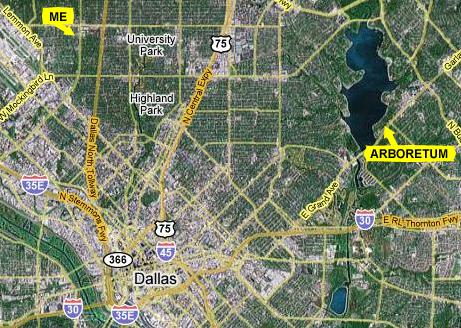 |
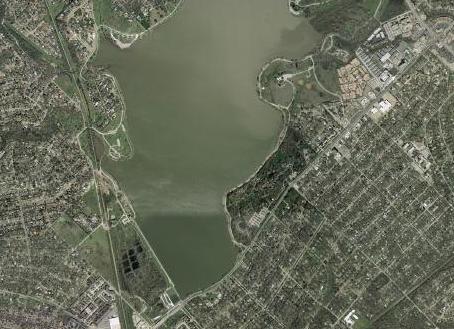 |
The bike path used to cross the top of the dam, but for one reason or another, the bike path was rerouted a year ago, and now it goes through some parkland and playing fields south of the dam, across the spillway, up Garland Road for a ways, and then back north along the lake shore.
You can also see a closer view of the Arboretum in this picture, and can begin to pick out some of the pathways through the gardens.
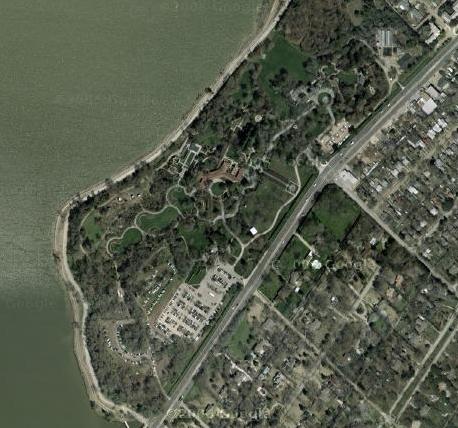 |
You can also see the maze of pathways that criss-cross the gardens.
Although we usually make a circular transit of the entire Arboretum each time we visit, our primary purpose today is to make sure that we see all of the Chihuly glass installations- and there are quite a few of them. I know that is probably not important for you to know where in the gardens each of the Chihuly installations is located, I always think it is interesting to let you follow along with us on a map or diagram. Below is a large diagram of the Dallas Arboretum, with our general route marked in yellow and the major gardens noted in red.
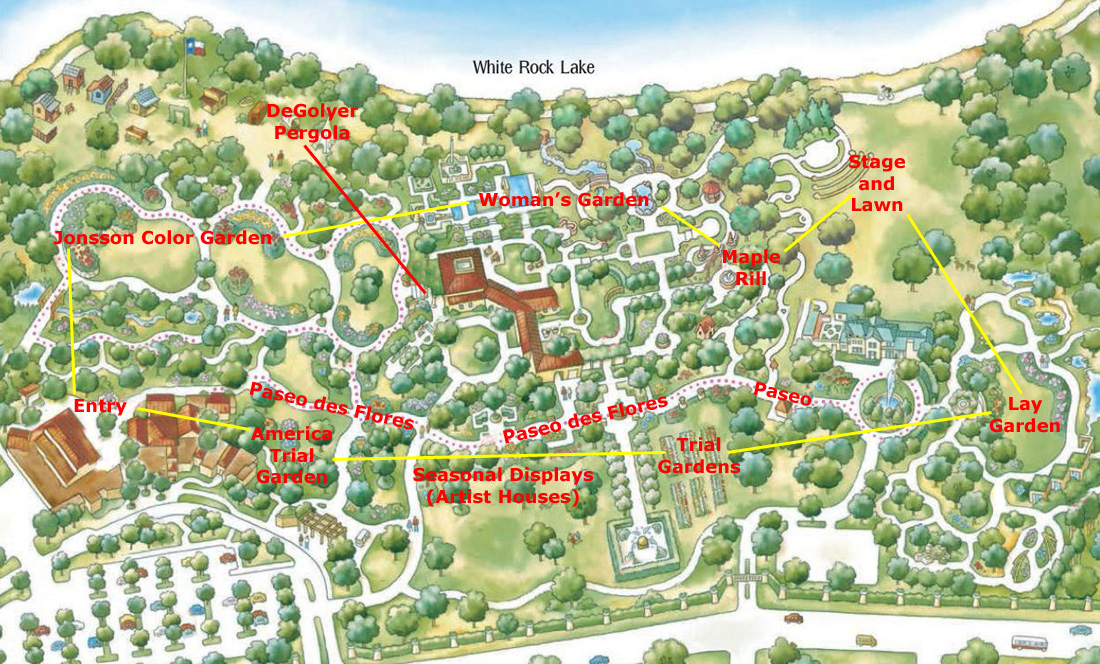
|
I'll divide up today's pictures by garden, and with each group you'll find a little inset map with our current location marked and the Chihuly installation(s) we found there also marked. Some of the installations, such as "Garden Grass," have multiple iterations and can be found in multiple locations. I will try to mark as many of them as I can. So let's head off from the parking area into the Arboretum to have a look at both the glass installations and the gardens themselves.
When we were here with Rudolf a month ago, we saw (and photographed) every Chihuly piece in the Gardens. Today, we missed a couple, so if you haven't already visited the exhibit with us via this photo album, and want the complete picture of it, you might want to return to the index and use the page for July 22nd to see everything.
Cissy Thomsen Welcoming Water Wall
Installation Name: Blue Icicles
|
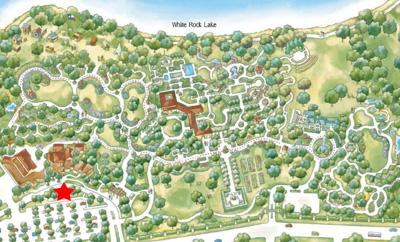
|
In 1996, Chihuly developed an element for his Icicle Creek Chandelier that he hoped could withstand the snowy winters and hot summers of Central Washington state. The resulting icicle form, both beautiful and sturdy, has become a favorite of the artist in a number of outdoor installations since then. One icicle part in your hand is remarkably heavy. Wherever they are placed outdoors, and no matter what the color, the add a startling visual punch. Here at the Arboretum, the clear, turquoise and cobalt icicles reflect the Texas sunlight in dramatic fashion. Here is a second view of Fred and Guy at the installation.
Ginsburg Plaza
Installation Name: Mexican Hat and Horn Tower
|
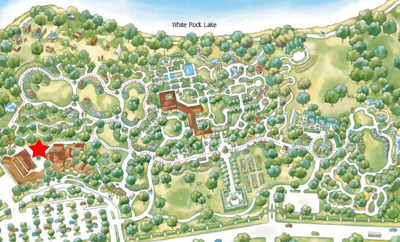
|
Mexico was one of the countries where Chihuly blew glass during the Chihuly Over Venice project and the red forms in the Mexican Hat and Horn Tower were devised there. Often, he and the team will invent a new shape for the Chandeliers or Towers and the new parts will take on a nickname- in this case, "Mexican Hats." In addition to the picture above, left, I got a good one of Fred and Guy at the installation.
The Palmer Fern Dell
|
Here, we found the first of many installations of a genre that Chihuly calls, simply, "Garden Glass." These were tall, slender grass-like shapes, sometimes straight and sometimes with curliques at the top. The color seemed to complement the place in the garden where they were located. Usually, they had different names.
Installation Name: Blue Marlins and Turquoise Reeds
|
In addition to the Blue Marlins seen at right, the fern dell also contained three sets of the Turquoise Reeds. Chihuly made the first Reeds at the Hackman factory in Nuutajarvi, a small glassblowing town in Finland. Unlike other factories, the Hackman facility has very high ceilings, which inspired Chihuly to make these elongated forms. To create the long tubular shape of a Reed, one glassblower must be elevated in a mechanical lift while blowing through the pipe to encourage the form to stretch, while another pulls the glass toward the ground. As Chihuly said, "In Finland we started making these long, cylindrical pieces which loojked like spears. This was an exciting new form. It was the first time we ever made anything like that. They can be taken anywhere; they can go outside. They are very strong pieces, and they are very dramatic."
Both the different installations were very pretty, and their deep blue color suited the deep shade of the fern dell.
The Jonsson Color Garden
|
Here, we found a number of different Chihuly glass installations.
Installation Name: Yellow Icicle Tower
The Yellow Icicle Tower shoots up 30 feet and is a perfect example of Chihuly's desire to mass color for dramatic effect. The combined elements create what Chihuly once described as "a core of color." Among the things for which Chihuly is most known are his monumental blown glass sculptures like this one. You can see it in the background behind Guy and myself.
Installation Name: Yellow Reeds
|
Installation Name: Tiger Lillies
|
Installation Name: Niijima Floats
|
A Woman's Garden
|
The main entrance to the garden is through the portal at the northeast end of the Jonsson Color Garden; this brings the visitor to the top of a stairstepped water feature that leads down into the garden. Small channels of water surround the plain grass center of the area. Steps lead up from this garden to the DeGolyer House.
Going through the portal, we find ourselves at the upper fountain at the beginning of the stairstepped water feature leading downwards.
Installation Name: Neodymium Reeds
|
Chihuly made the first Reeds in Finland, and these are the same tall, thin sculptures that we would find throughout the garden, in different colors to complement their location. These long, cylindrical pieces look like spears stuck in the ground, and Chihuly is fond of using them in outdoor installations both for their durability and their dramatic effect. These reeds have another, different sculpture at their base (a piece that was unnamed).
Installation Name: Aqua Blue and Amber Chandelier
|
Installation Name: Mirrored Hornets
|
For the Mirrored Hornets, molten glass is blown into a spiral mold to make the Hornet form. The glassblower must literally unscrew the hot glass to remove the form from the mold.
There's one more picture that I'd like you to see. Fred took it from the eastern end of the rectangular lawn, and it looks back west and includes the Mirrored Hornets, the Neodymium Reeds, the stairstep water feature and, beyond that, the entrance to the Woman's Garden and a pair of glass sculptures called Asymmetrical Towers. You can see that view here.
Installation Names: Float Boat and Carnival Boat
The next two installations were both in the infinity pool at the east end of the Woman's Garden, and they were both strikingly beautiful.
|
As I said, these installations, and the individual floats around them, were quite beautiful; the combination of the colorful sculptures and the blue water of the infinity pool plus the backdrop of White Rock Lake made for an entrancing scene. So I want to include a few more of the pictures that we took of these installations, and I have provided clickable thumbnails for them below:
 |
The Grotto
|
Installation Name: Persian Pond
|
Chihuly began his Persians series in 1986 as a search for new forms, always for Chihuly being a vehicle for color. Early works in the series were oddly shaped and intensely colored but were soon transformed. As Chihuly continued to expand and modify his Persians, he began to see their potential for large, dramatic installations.
The Red Maple Rill
|
“The most impressive feature is a fabulous collection of over 80 varieties of 200 Japanese Maples,” commented Dave Forehand, Vice President of Gardens. “Two hundred trees are planted up and down the stream with an understory planting beneath the canopy. An especially large weeping Japanese maple nearly 100 years in age anchors the center of this new garden area.”
The Red Maple Rill increases the Dallas Arboretum’s collection of Acer species and cultivars to over 120 varieties. Not only is this garden a beautiful serene oasis along the Paseo, but is also a horticulturally important garden with an impressive collection of Maple species and cultivars.
Installation Name: Sun
|
The installation sits at the edge of the Martin Rutchik Concert Lawn, just on the lawn side of the bridge that crosses the Rill. It does indeed look like a small sun that has descended to touch the earth.
Lay Ornamental Garden
|
Both the Lay and Trammel Crow families are major participants in Dallas philanthropy. Trammel Crow began as a small property owner and Realtor, and his companies expanded to become a leading name in office rental properties and new construction nationwide. Herman Lay, who died in 1982, began as a Pepsi-Cola bottler in Mexico, and expanded into snack foods in the 1950s. His name is currently one-half of the famous Frito-Lay snack empire which, in a not-so-odd turn, is part of PepsiCo- Herman Lay's first employer. Both men and their families have also been involved with the Morton Myerson Symphony Hall. The Trammel Crow family continues to sponsor concerts, and a branch of the Lay family donated the huge pipe organ that is the pride of the Myerson.
Installation Name: Fiori Sun
|
The installation was certainly amazing, lit as it was by the bright Dallas summer sun.
Installation Name: Turquoise and Clear Eelgrass
|
We walked westward from the waterwalls to the entrance to the Lay Garden and our access out to the Paseo de Flores.
Paseo de Flores
|
Installation Name: Red Reeds
|
Chihuly made the first Reeds in Finland; the factory's high ceilings made the tall, thin glass sculptures possible (well, that and a mechanical life to raise the glassblower high off the floor). As Chihuly said, "In Finland we started making these long, cylindrical pieces which loojked like spears. This was an exciting new form. It was the first time we ever made anything like that. They can be taken anywhere; they can go outside. They are very strong pieces, and they are very dramatic."
That is certainly true of this installation. The red cast from the glass even made the lily pads in the fountain appear reddish.
Installation Name: Ruby Fiddleheads
|
Installation Name: Dallas Star
|
The Dallas Star was certainly an energetic piece, and while energy is a characteristic found in all of Chihuly's artwork, this installation exemplified it perhaps better than any other. When asked about the way he works, Chihuly answered, "Quick and immediate and spontaneous, with an element of chance." And asked about where ideas come from he said: "The only explanation I'm ever able to give about where things come from is 'energy.' That has to come out in one way or another. Sometimes it's more destructive, sometimes it's more beautiful, sometimes more creative. Energy can go in so many directions, and you have to harness it. Correction! Youy don't harness it, you use it. You put it to good use."
Back on the Paseo, we headed towards the entrance and the last two Chihuly installations.
| Installation Names: | Green and White Striped Reeds Black and White Striped Reeds |
|
But then we thought that all of Chihuly's pieces were dramatic.
We continued walking down the Paseo de Flores and back to the entrance. The day had gotten very, very warm, and while the sculptures were amazing to look at, we were all ready for some shade and cool air back at home.
Some Time at Home
That afternoon, I was accompanied by the cats as Fred and I did some Internet surfing. I happened to be watching some news videos, which gave me the idea for a staged photograph. I have put that photograph below. You may be able to figure out what it is all about but, if you can't, just email me at website (at) rondougherty (period) com and I'll explain it:
 |
HINT: If you can't read it clearly, the title of the book in the chair is "Convention".
You can use the links below to continue to another photo album page.
 |
September 18, 2012: Summer's End at Downhill Run Acres |
 |
August 4-15, 2012: Housesitting in San Antonio |
 |
Return to the Index for 2012 |